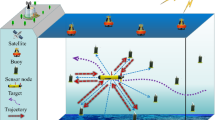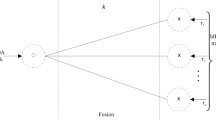Abstract
In an underwater environment, measurements regarding true targets and false targets (clutter) can be made. Therefore, a suitable data association method to exactly detect and track a target and an efficient track initiation method for judging tracks formed by the target should be selected in this environment. This paper attempts to propose a new data association method and track initiation method to detect and track targets more effectively. Also, the performance of the new method is tested in a series of Monte Carlo simulation runs and is compared with the existing data association and track initiation methods in a cluttered environment.
Similar content being viewed by others
References
X. R. Li and Y. Bar-Shalom, “Tracking in clutter with nearest neighbor filter: Analysis and performance,” IEEE Trans. on Aerospace and Electronic Systems, vol. AES-32, no. 3, pp. 995–1010, July 1996.
T. L. Song and D. G. Lee, “A probabilistic nearest neighbor filter algorithm for m validated measurement,” IEEE Trans. on Signal Processing, vol. 54, no. 7, pp. 2797–2802, July 2006.
X. R. Li, “Tracking in clutter with strongest neighbor measurement-Part I: theoretical analysis,” IEEE Trans. on Automatic Control, vol. AC-43, no. 11, pp. 1560–1578, November 1998.
T. L. Song, Y. T Lim, and D. G. Lee, “A probabilistic strongest neighbor filter algorithm for m validated measurement,” IEEE Trans. on Aerospace and Electronic System, vol. 45, no. 2, pp. 431–442, April 2009.
T. Kirubarajan and Y. Bar-Shalom, “Probabilistic data association techniques for target tracking in clutter,” Proceedings of IEEE, vol. 92, no. 3, pp. 536–557, March 2004.
D. Lerro and Y. Bar-Shalom, “Interacting multiple model tracking with target amplitude feature,” IEEE Trans. on Aerospace and Electronic System, vol. 29, pp. 494–509, April 1993.
D. Musicki, R. Evans, and S. Stankovic, “Integrated probabilistic data association,” IEEE Trans. on Automatic Control, vol. 39, no. 6, pp. 1237–1241, June 1994.
X. R. Li and N. Li, “Intelligent PDAF: Refinement of IPDAF for tracking in clutter,” Proc. of the 29th Southeastern Symposium on System Theory, p. 133, 1993.
T. L. Song, “Most probable data association with distance and amplitude information for target tracking in clutter,” Proc. of IEEE International Conference on Multisensor Fusion and Integration for Intelligent Systems, Seoul, Korea, August 2008.
N. Li and X. R. Li, “Target perceivability and its applications,” IEEE Trans. on Signal Processing, vol. 49, no. 11, pp. 2588–2604, November 2001.
Author information
Authors and Affiliations
Corresponding author
Additional information
Recommended by Editorial Board member Young Jae Lee under the direction of Editor Young Il Lee.
Seung-Woo Kim received his B.S. degree in Electrical Engineering from Kumoh National University in 2001 and his M.S. degree in Electrical Engineering from Pusan National University in 2003. He is now with the Defense Agency for Technology and Quality, Korea. His research interests include audio compression, digital signal process, and target tracking.
Young-Taek Lim received his B.S. degree in Control and Instrumentation Engineering from Hanyang University, Korea, in 2000, and received his M.S. and Ph.D. degrees in Electronics, Electrical, Control and Instrumentation Engineering from Hanyang University, Korea, in 2002 and 2007, respectively. Since 2007, he has been with Samsung Thales Co., LTD., Korea, where he is a senior research engineer. His research interests are in target motion analysis, target tracking, data association, data fusion and engagement naval systems.
Taek-Lyul Song received his Ph.D. degree in Aerospace Engineering from the University of Texas at Austin in 1983. He is a Professor in the Department of Electronics, Electrical, Control and Instrumentation Engineering, Hanyang University, Korea. His research interests include target state estimation, guidance, navigation and control.
Rights and permissions
About this article
Cite this article
Kim, SW., Lim, YT. & Song, TL. A study of a new data association and track initiation method with normalized distance squared ordering. Int. J. Control Autom. Syst. 9, 815–822 (2011). https://doi.org/10.1007/s12555-011-0501-z
Received:
Revised:
Accepted:
Published:
Issue Date:
DOI: https://doi.org/10.1007/s12555-011-0501-z




